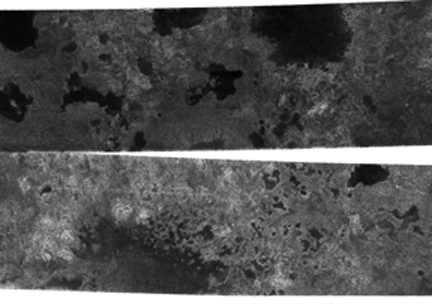|
Web Extra Monday, July 31, 2006
Titanic methane mystery solved?
 Minnesota,
known for its numerous lakes, now has a space-based analog on Saturn's
moon, Titan. Images captured on July 22 by NASA's Cassini spacecraft during
its first flyby of Titan's north pole revealed a landscape littered with
dozens of lakes — possibly filled with liquid methane — which
could help solve the long-running mystery about Titan's missing source
of atmospheric methane.
Minnesota,
known for its numerous lakes, now has a space-based analog on Saturn's
moon, Titan. Images captured on July 22 by NASA's Cassini spacecraft during
its first flyby of Titan's north pole revealed a landscape littered with
dozens of lakes — possibly filled with liquid methane — which
could help solve the long-running mystery about Titan's missing source
of atmospheric methane.
Planetary scientists discovered
dozens of lakes, some connected by river-like channels, at Titan's north
pole. Researchers suggest that the lakes could hold enough liquid methane
to resupply the Saturnian moon's atmosphere with methane gas. Image is
courtesy of NASA/JPL.
Prior to Cassini's arrival at Saturn and its moons in July 2004, researchers on Earth measured nearly steady levels of methane gas in Titan's atmosphere. They knew that ultraviolet light in the atmosphere breaks down the gas and strips it away, so they concluded that some source must exist to replenish the gas. A giant surface or subsurface methane ocean was one possible explanation, and other possibilities included methane-filled lakes or methane volcanoes.
The ongoing mission has so far ruled out the presence of a widespread
ocean, and until now, only one lake (about the size of Earth's Lake Ontario)
at Titan's south pole had been discovered (see Geotimes
online, Web Extra, July 1, 2005). That lake alone would not have been
sufficient to replenish Titan's atmosphere with methane. But the newly
imaged northern lakes could contain enough methane to possibly "solve
that problem," says Alfred McEwen, a planetary geologist at the University
of Arizona in Tucson and a Cassini imaging team member.
The lakes appear on two radar images as irregular black blotches that
range in size from about 1 kilometer to 32 kilometers across, according
to a July 27 NASA press release. A radar device onboard
the spacecraft also indicated that the lakes were almost perfectly smooth,
which is "very suggestive" of liquid, says Carolyn Porco, the
Cassini imaging team leader at the Space Science Institute in Boulder,
Colo. That liquid, which on Titan would likely be methane, could resupply
Titan's atmosphere, she says.
The evidence, however, does not provide a "smoking gun," McEwen says, and it is "still an open question" as to whether the features hold liquid methane, and thus replenish Titan's atmosphere, or they are dry — leaving the source of atmospheric methane a mystery. Porco agrees, and says that the features are not "unambiguous lakes." The dark, smooth features could also result from deposited or evaporite material.
The imaging team plans to look for additional lakes when Cassini next
passes close to the north pole on Sept. 7, according to NASA. Researchers
could also obtain additional evidence of liquid by watching to see if
the lakes shrink or expand with the changing seasons. Titan's north pole
is currently enveloped in late winter darkness, but the equinox will bring
light there in 2009, McEwen says, adding, "I'm interested in seeing
Titan through that change."
Kathryn Hansen
Links:
NASA
press release
"Icy
methane volcano on Titan," Geotimes,
August 2005
"Titanic lake?"
Geotimes online, Web Extra, July 1, 2005
"Frozen volcanism on Titan,"
Geotimes, January 2005
NASA's
Cassini-Huygens site

 Subscribe
Subscribe

